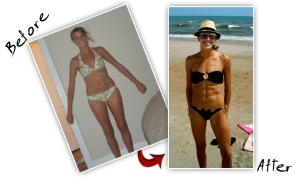How to Flatten Your Stomach: 3 Tummy Types
One of the most frequently asked questions that I get (almost daily) from women is, “How can I flatten my stomach?!” Now that bikini and beach season is in full swing, moms are frantically looking for ways to tackle that trouble spot.

There’s no one-size-fits-all method for flattening your stomach. Instead, the most successful approach starts with determining where your true tummy trouble lies. Once you figure out your tummy trouble type, you can develop a plan to beat the belly fat and flatten your stomach once and for all.
But don’t take my word for it – just take a peek. Even in my early years as a personal trainer, I struggled with getting the tight, toned tummy I wanted! I thought I ate healthfully and spent hours in the gym. Yet my results just didn’t match up to the WORK I put in.

I was a “slim-but-stressed stomach” tummy type! Figuring this out made all the difference in finally getting the results I wanted!
What’s YOUR tummy type?
The 3 Most Common Tummy Types:
1) Slim-but-Stressed Stomach
What to look for: Women who appear thin but carry excess, stubborn fat around the middle are what I refer to as “slim-but-stressed.” These tummies typically store fat around the waist and belly button areas. Their stomachs tend to feel firm, rather than jiggly.
Slim-but-stressed women tend to be overachievers or perfectionists who stress easily, worsening their tummy troubles and making it even harder to flatten their stomachs. When our bodies experience stress–whether emotional or physical (usually from excessive exercise)–we produce cortisol. Cortisol, when combined with other fat-storing hormones, the wrong types of exercise, and the wrong types of nutrition, all add up to extra fat storage around the middle. Skipping meals and increased intake of caffeine or adrenal issues are good indicators that you fall into this tummy type. Women with slim-but-stressed tummies also tend to be susceptible to digestive issues that may cause bloating and worsen the appearance of the middle.
What to do: First, you must prioritize sleep and make rest and recovery the focus of your fitness plan. Slim-but-stressed women often have sleep issues, thus disrupting the production of the hormone, leptin, which helps regulate appetite and causes your body to feel full. (Ever crave fatty, sugary treats and/or eat more when you’re tired/stressed?!) Set a daily bedtime and trade your long duration, moderate intensity workouts for short duration, high intensity resistance training. Add slow, leisurely walking to your daily routine as much as possible. Limit caffeine consumption, and focus on increasing magnesium intake to help with sleep and stress.
2) Post Baby Belly
What to look for: Women who have a post baby belly aren’t necessarily “new” moms. In fact, many of the clients that I work with who fall under this type of tummy trouble have 8, 9, or even 10+ year old children. These women typically have very little time for themselves and have failed to re-train their pelvic floor and lower abs post-baby. Months (or even years) of bad posture, a weak core, and a poor diet lead to a lower ab “pooch” that you can’t seem to banish.
Post baby belly women may also have a diastasis recti that has never healed. During pregnancy, the growing uterus stretches the muscles in the abdomen. This can cause the two large parallel bands of muscles that meet in the middle of the abdomen to separate. In many moms, diastasis recti causes a bulge in the middle of the abdomen where the two muscles separate.
The muscle separation often lessens in the months after childbirth. However, some degree of separation might remain for about a year after childbirth, though it can stay for longer. Women with post baby belly often have weakened abdominal muscles, causing lower back pain in addition to their tummy trouble.
What to do: Don’t listen to the magazines, websites or uniformed trainers that require 1000s of crunches to get flat abs. I didn’t do a single crunch after I had my son Jackson. Yet I got a 6 pack within 6 months postpartum and completely closed my diastasis recti! (For all of the specific exercises I did, check out Beyond Baby. Hint: Not ONE of them included a crunch. In fact, crunches prove the worst thing you can do, as they may further aggravate your condition!)
If you suffer from post baby belly, focus on specific tummy flattening core training exercises. Additionally, quality fat-loss nutrition proves essential. You may consider taking a quality fish oil supplement as well as whey protein or BCAAs in addition to your core training and optimal fat loss nutrition plan.
3) Bloated Belly
What to look for: Women with a bloated belly often have a flat stomach in the morning that fills with gas throughout the day. Typically I see three causes for bloating and digestion issues in my clients: poor diet, food intolerances/allergies, and metabolic damage. Poor diets and food intolerances are by far the most common offenders of digestion issues and bloating. The most common intolerances come from wheat/gluten and processed dairy.
What to do: If you think you may suffer from a bloated belly, take a look at your diet and try eliminating key culprits. Generally it takes two weeks of elimination to see a reduction in bloating. Slowly reintroduce that food and take notes on which foods make it seem worse. Focus on a diet of lean proteins, fibrous veggies, and low-sugar fruits. Drink plenty of water to keep your digestive system moving. Once addressing the nutrition component, you may consider adding a quality probiotic supplement if you still notice a bloated belly. Probiotic supplements promote a healthy gut and repopulate your digestive system with friendly bacteria.
Did you find your tummy trouble type above?
For more exercise and nutrition information that will help you meet your tummy trouble head on, head over to the BeyondFit Life Club Members Portal where you can INSTANTLY download workouts and recipes!
